The Seven Wonders of the World has historically been a listing of seven sites known to the Ancient Greeks as the most notable locales in their known world. Since then, many have developed lists of the "modern" Seven Wonders of the World. Likewise, there had been confusion and debate on listing some of the truly god's gifted Natural Wonders in the world. However, In 1997, CNN announced a listing of the Seven Natural Wonders of the World. Seven Natural Wonders was established to protect the original vision and declaration of the seven natural wonders of the world. Although there is some dispute about the exact list, CNN published the commonly accepted list.
- The Grand Canyon ( USA ):
The Grand Canyon is a steep-sided canyon carved by the Colorado River in the United States in the state of Arizona. It is contained within and managed by Grand Canyon National Park, the Hualapai Tribal Nation, and the Havasupai Tribe. It is considered one of the Seven Natural Wonders of the World.
 Though widely considered one of the world's most spectacular canyons, the Grand Canyon is neither the world's longest or deepest gorge. Its average depth is about 1 mile (1.6 kilometers), though the canyon ranges from 2,400 feet (731 meters) deep below Yavapai Point on the South Rim to 7,800 feet (2,377 m) deep at the North Rim. The canyon wends 277 miles (446 km) along its sinuous path. Recent evidence suggests the Colorado River established its course through the canyon at least 17 million years ago.
Though widely considered one of the world's most spectacular canyons, the Grand Canyon is neither the world's longest or deepest gorge. Its average depth is about 1 mile (1.6 kilometers), though the canyon ranges from 2,400 feet (731 meters) deep below Yavapai Point on the South Rim to 7,800 feet (2,377 m) deep at the North Rim. The canyon wends 277 miles (446 km) along its sinuous path. Recent evidence suggests the Colorado River established its course through the canyon at least 17 million years ago. Around 450 Native Americans live in the canyon year-round in Supai, on the Havasupai Reservation. The Havasupai have lived in the canyon for hundreds of years. Traditionally they farmed the fertile soil in Cataract Canyon in the summer raising maize, squash, beans, and peaches. In the winter they hunted game on the rim for sustenance.
There is a diverse population of life in the canyon, where over 1,500 plant, 500 types of animals are found. The canyon offers a nearly undisturbed natural habitat through a range of elevations from desert to mountain forests on the rims.
2. Rio De Janeiro ( Brazil ) :
Simply reffered as Rio, is the capital city of the State of Rio de Janeiro, the second largest city of Brazil. A Part of the city has been certified as a World Heritage Site, named "Rio de Janeiro: Carioca Landscapes between the Mountain and the Sea", identified by UNESCO on 1 July 2012 in the category Cultural Landscape.
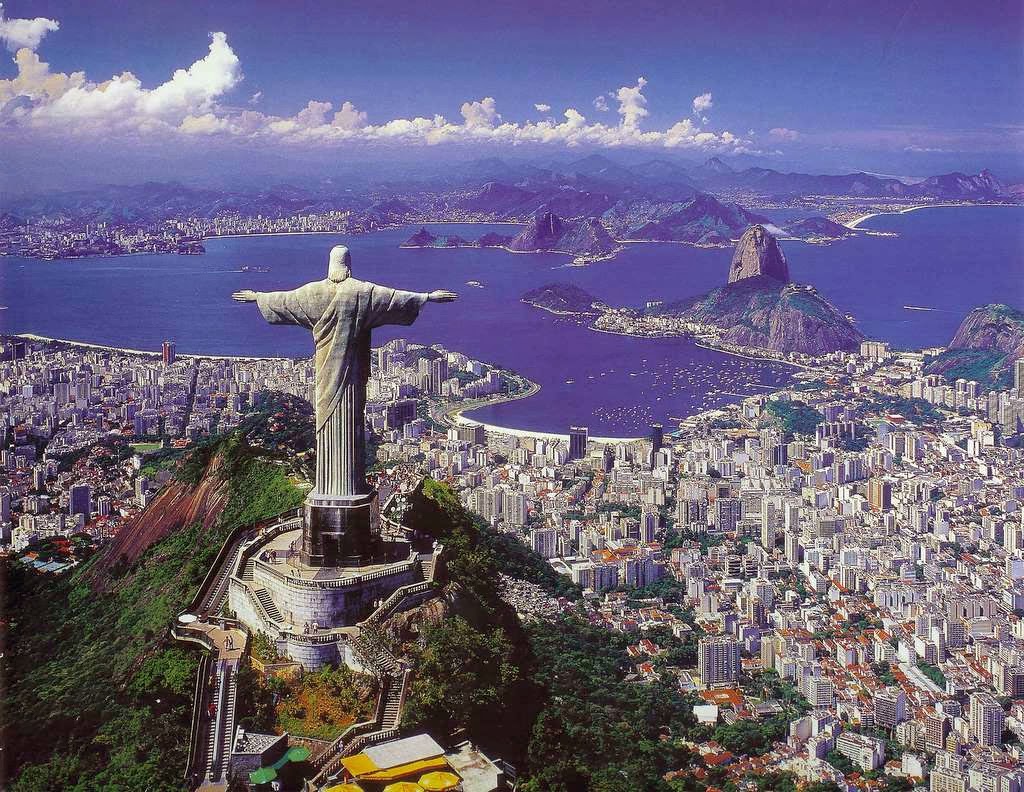 Rio was discovered in 1502 by the Portuguese as a fortification against French privateers who trafficked wood and goods from Brazil. The discovery was by the Portuguese seafarer, Concalo Coelho on January 1. He called it Rio de Janeiro which is Portuguese for "River of January".
Rio was discovered in 1502 by the Portuguese as a fortification against French privateers who trafficked wood and goods from Brazil. The discovery was by the Portuguese seafarer, Concalo Coelho on January 1. He called it Rio de Janeiro which is Portuguese for "River of January".The Harbor of Rio de Janeiro is one of the Seven Natural Wonders of the World. It is world famous for being the world's largest bay, having mountains that come down almost to the water's edge and for an enormous statue that looks down on the city and harbor from one the mountain peaks.
The Harbor of Rio de Janeiro is located in Brazil and was created by erosion from the Atlantic Ocean and is also known as Guanabara Bay. The Harbour is surrounded by gorgeous granite monolith mountains that include the famous Sugar Loaf Mountain at 1,296 feet (395 m), Corcovado Peak at 2,310 feet (704 m), and the hills of Tijuca at 3,350 feet (1021 m).These mountains are a part of a mountain chain that runs 1,500 miles (2414 km) along the coast of South America. On top of Mt. Corcovado there is a 130 foot (39.6 m) tall statue of Jesus Christ. The arms of the statue extend 98 feet (30 m) across. It weighs 635 tons. The statue is called "Christ the Redeemer".
3. Aurora Borealis (Arctic and Antarctic ):
An aurora, sunrise or the Roman goddess of dawn is a natural light display in the sky particularly in the high latitude regions, caused by the collision of energetic charged particles with atoms in the high altitude atmosphere.The bright dancing lights of the aurora are actually collisions between electrically charged particles from the sun that enter the earth's atmosphere. The lights are seen above the magnetic poles of the northern and southern hemispheres. They are known as 'Aurora borealis' in the north and 'Aurora australis' in the south. Auroral displays appear in many colours although pale green and pink are the most common. Shades of red, yellow, green, blue, and violet have been reported. The lights appear in many forms from patches or scattered clouds of light to streamers, arcs, rippling curtains or shooting rays that light up the sky with an eerie glow.
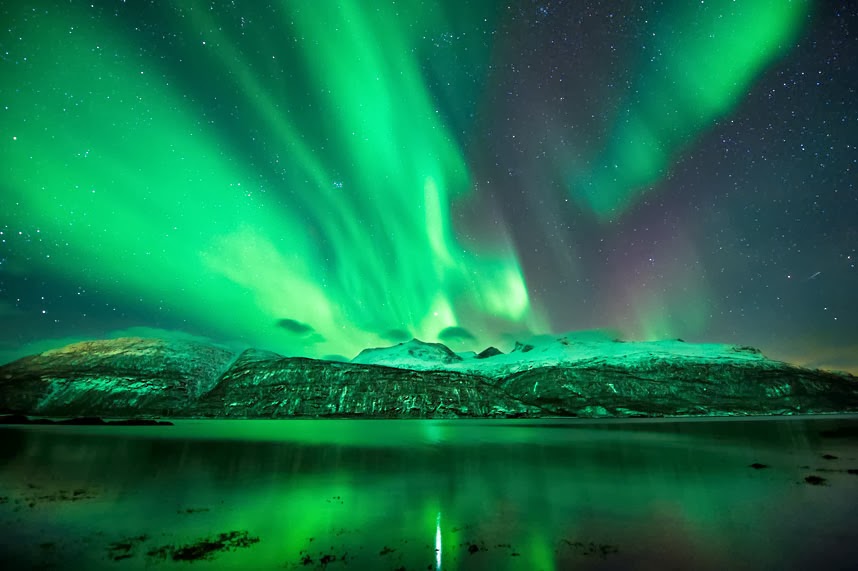 The Northern Lights are actually the result of collisions between gaseous particles in the Earth's atmosphere with charged particles released from the sun's atmosphere. Variations in colour are due to the type of gas particles that are colliding. The most common auroral color, a pale yellowish-green, is produced by oxygen molecules located about 60 miles above the earth. Rare, all-red auroras are produced by high-altitude oxygen, at heights of up to 200 miles. Nitrogen produces blue or purplish-red aurora.
The Northern Lights are actually the result of collisions between gaseous particles in the Earth's atmosphere with charged particles released from the sun's atmosphere. Variations in colour are due to the type of gas particles that are colliding. The most common auroral color, a pale yellowish-green, is produced by oxygen molecules located about 60 miles above the earth. Rare, all-red auroras are produced by high-altitude oxygen, at heights of up to 200 miles. Nitrogen produces blue or purplish-red aurora.
The connection between the Northern Lights and sunspot activity has been suspected since about 1880.
4. The Great Barrier Reef ( Australia ) :
The Great Barrier Reef is the world's largest coral reef systemcomposed of over 2,900 individual reefs and 900 islands stretching for over 2,600 kilometres (1,600 mi) over an area of approximately 344,400 square kilometres (133,000 sq mi).The reef is located in the Coral Sea, off the coast of Queensland, Australia. It is the world's biggest single structure made by living organisms. This reef structure is composed of and built by billions of tiny organisms, known as coral polyps.It supports a wide diversity of life and was selected as a World Heritage Site in 1981. CNN labeled it one of the seven natural wonders of the world. The Queensland National Trust named it a state icon of Queensland.
5. Mount Everest ( Nepal and Tibet ) :
Mount Everest or Sagarmatha is the Earth's highest mountain, located in the Mahalangur section of the Himalayas. Its peak is 8,848 metres (29,029 ft) above sea level and the 5th furthest point from the centre of the Earth. It lies on border between China and Nepal. The official altitude of the world's highest peak is 29,029 feet (8,848 m), however, National Geographic Society has determined the height to be 6 feet taller, 29,035 feet, but the Nepali government has not yet been made this new altitude official.
 In 1841, Sir George Everest, Surveyor General of India from 1830 to 1843, first recorded the location of Everest. It was subsequently named "Peak XV". In 1865, it was renamed Mt. Everest to honor Sir George. Nepalese call it as Sagarmatha, which means " Head of the Earth touching the Heaven".
In 1841, Sir George Everest, Surveyor General of India from 1830 to 1843, first recorded the location of Everest. It was subsequently named "Peak XV". In 1865, it was renamed Mt. Everest to honor Sir George. Nepalese call it as Sagarmatha, which means " Head of the Earth touching the Heaven".
On 29th may 1953, using the southeast ridge route, New zealand's climber Sir Edmund Hillary and a Nepali climber Tenzing Norge Sherpa reached the Everest Summit for the very first time. Before that many climbers had tried to reach the summit but no succesful climb was made. It was second attemp for Tenzing to the top, Tenzing had reached 8,595 m (28,199 ft) the previous year as a member of the 1952 Swiss expedition.
Since 1953 many records have been broken and many Sherpas have climbed more than 10 times. Many of climbers today climbs everest to set new records such as speed record, to become youngest or oldest, first American or the first woman. Likewise, Appa Sherpa who, jointly with Phurba Tashi, holds the record for reaching the summit of Mount Everest more times than any other person. He has climbed the mountain twenty-one times as of May 2013 and as of May 2000, 11 times without Oxygen along with Ang Rita and Babu Chiri Sherpa ( both 10 times without oxygen).
Everest presents dangers such as altitude sickness, weather, wind as well as significant objective hazards from avalanches and the Khumbu Icefall ( The most Dangerous Zone of Everest ). The Worst years of Everest is said to be year of 1993, where out of 129 submitter, 8 died and in 1996, 98 submitted and 15 died.
6. Paricutin ( Mexico ) :
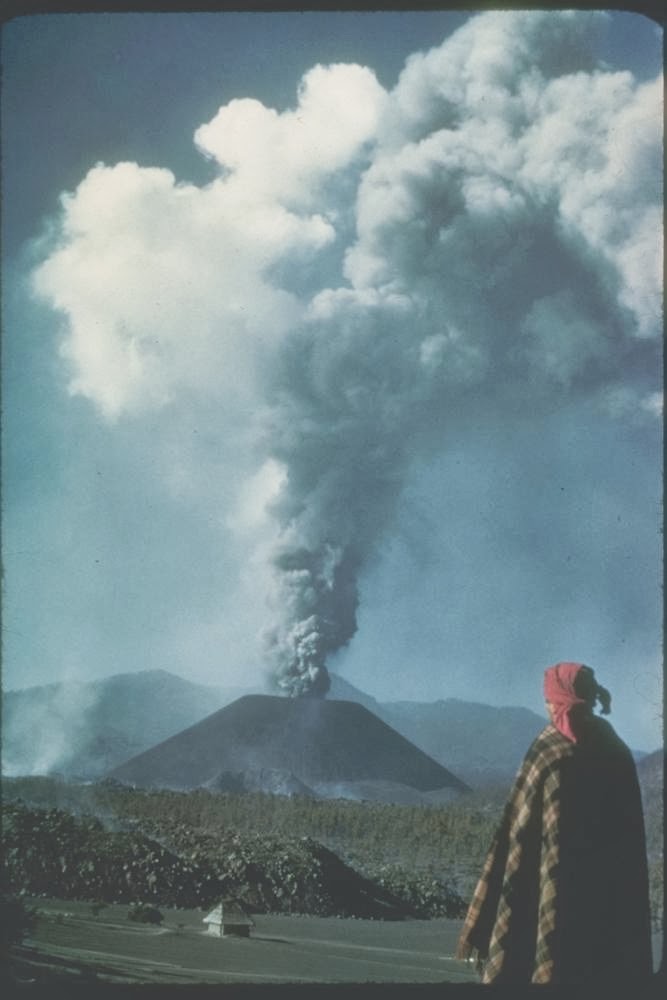 Parícutin or Volcan de Paricutin, is a cinder cone volcano in the Mexican state of Michoacan, close to a lava-covered village. It is unique in the fact that, Paricutín is one of the few volcanoes whose birth has been witnessed by man. The volcano began as a fissure in a cornfield owned by a Purhepecha farmer, Dionisio Pulido, on February 20, 1943. He and his wife witnessed the initial eruption of ash and stones first-hand. Dionisio Pulido and his wife Paula were burning shrubbery in their cornfield. The volcano grew quickly, reaching five stories tall in just a week, and it could be seen from afar in a month. Much of the volcano's growth occurred during its first year, while it was still in the explosive phase. At the end of this phase, after roughly one year, the volcano had grown 336 metres (1,102 feet) tall. For the next eight years the volcano continued erupting, although this was dominated by relatively quiet eruptions of lava that scorched the surrounding 25 square kilometres (9.7 square miles; 6,200 acres) of land. The volcano's activity slowly declined during this period until the last six months of the eruption, during which violent and explosive activity was frequent. In 1952, the eruption ended and Parícutin went quiet, attaining a final height of 424 metres (1,391 feet) above the cornfield where it began. The volcano has been quiet since then. The type of eruption which happened at Paricutin is called a Strombolian eruption, which means it gushed basaltic lava, and exploded from a single vent. Nearly 1000 people died following one of its last major eruptions in 1949. The Paricutin is part of the Volcanic Axis, "The Transversal", a 700 mile line of volcanoes that extends across southern Mexico in an east-west direction.
Parícutin or Volcan de Paricutin, is a cinder cone volcano in the Mexican state of Michoacan, close to a lava-covered village. It is unique in the fact that, Paricutín is one of the few volcanoes whose birth has been witnessed by man. The volcano began as a fissure in a cornfield owned by a Purhepecha farmer, Dionisio Pulido, on February 20, 1943. He and his wife witnessed the initial eruption of ash and stones first-hand. Dionisio Pulido and his wife Paula were burning shrubbery in their cornfield. The volcano grew quickly, reaching five stories tall in just a week, and it could be seen from afar in a month. Much of the volcano's growth occurred during its first year, while it was still in the explosive phase. At the end of this phase, after roughly one year, the volcano had grown 336 metres (1,102 feet) tall. For the next eight years the volcano continued erupting, although this was dominated by relatively quiet eruptions of lava that scorched the surrounding 25 square kilometres (9.7 square miles; 6,200 acres) of land. The volcano's activity slowly declined during this period until the last six months of the eruption, during which violent and explosive activity was frequent. In 1952, the eruption ended and Parícutin went quiet, attaining a final height of 424 metres (1,391 feet) above the cornfield where it began. The volcano has been quiet since then. The type of eruption which happened at Paricutin is called a Strombolian eruption, which means it gushed basaltic lava, and exploded from a single vent. Nearly 1000 people died following one of its last major eruptions in 1949. The Paricutin is part of the Volcanic Axis, "The Transversal", a 700 mile line of volcanoes that extends across southern Mexico in an east-west direction.
7. Victoria Falls ( Southern Africa ) :
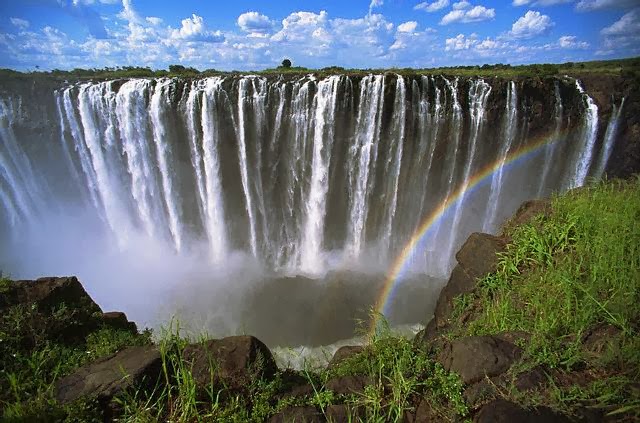 Victoria Falls, the name was given by the Scottish explorer Dr. David Livingstone in 1855, after the reining queen at the time. The locals called the falls Mosi-oa-Tunya meaning “smoke that thunders". It is one of the Seven Natural Wonders of the World. Located between Zambia and Zimbabwe, the Zambezi River widens to 1.7 km and then the full width of the river plunges 108 m down into the Zambezi Gorge. The force of the tumbling water, estimated at around 545 million litres per minute during the rainy season, sends clouds of spray up to 500m into the air, sustaining a lush rainforest all around.
Victoria Falls, the name was given by the Scottish explorer Dr. David Livingstone in 1855, after the reining queen at the time. The locals called the falls Mosi-oa-Tunya meaning “smoke that thunders". It is one of the Seven Natural Wonders of the World. Located between Zambia and Zimbabwe, the Zambezi River widens to 1.7 km and then the full width of the river plunges 108 m down into the Zambezi Gorge. The force of the tumbling water, estimated at around 545 million litres per minute during the rainy season, sends clouds of spray up to 500m into the air, sustaining a lush rainforest all around.
Victoria Falls is not the highest or the widest waterfall but it is thought to form the largest sheet of falling water in the world. It is double the height of Niagra Falls in the US and only rivaled in width by the beautiful Iguassu Falls in South America.
5. Mount Everest ( Nepal and Tibet ) :
Mount Everest or Sagarmatha is the Earth's highest mountain, located in the Mahalangur section of the Himalayas. Its peak is 8,848 metres (29,029 ft) above sea level and the 5th furthest point from the centre of the Earth. It lies on border between China and Nepal. The official altitude of the world's highest peak is 29,029 feet (8,848 m), however, National Geographic Society has determined the height to be 6 feet taller, 29,035 feet, but the Nepali government has not yet been made this new altitude official.
 In 1841, Sir George Everest, Surveyor General of India from 1830 to 1843, first recorded the location of Everest. It was subsequently named "Peak XV". In 1865, it was renamed Mt. Everest to honor Sir George. Nepalese call it as Sagarmatha, which means " Head of the Earth touching the Heaven".
In 1841, Sir George Everest, Surveyor General of India from 1830 to 1843, first recorded the location of Everest. It was subsequently named "Peak XV". In 1865, it was renamed Mt. Everest to honor Sir George. Nepalese call it as Sagarmatha, which means " Head of the Earth touching the Heaven".On 29th may 1953, using the southeast ridge route, New zealand's climber Sir Edmund Hillary and a Nepali climber Tenzing Norge Sherpa reached the Everest Summit for the very first time. Before that many climbers had tried to reach the summit but no succesful climb was made. It was second attemp for Tenzing to the top, Tenzing had reached 8,595 m (28,199 ft) the previous year as a member of the 1952 Swiss expedition.
Since 1953 many records have been broken and many Sherpas have climbed more than 10 times. Many of climbers today climbs everest to set new records such as speed record, to become youngest or oldest, first American or the first woman. Likewise, Appa Sherpa who, jointly with Phurba Tashi, holds the record for reaching the summit of Mount Everest more times than any other person. He has climbed the mountain twenty-one times as of May 2013 and as of May 2000, 11 times without Oxygen along with Ang Rita and Babu Chiri Sherpa ( both 10 times without oxygen).
Everest presents dangers such as altitude sickness, weather, wind as well as significant objective hazards from avalanches and the Khumbu Icefall ( The most Dangerous Zone of Everest ). The Worst years of Everest is said to be year of 1993, where out of 129 submitter, 8 died and in 1996, 98 submitted and 15 died.
6. Paricutin ( Mexico ) :
 Parícutin or Volcan de Paricutin, is a cinder cone volcano in the Mexican state of Michoacan, close to a lava-covered village. It is unique in the fact that, Paricutín is one of the few volcanoes whose birth has been witnessed by man. The volcano began as a fissure in a cornfield owned by a Purhepecha farmer, Dionisio Pulido, on February 20, 1943. He and his wife witnessed the initial eruption of ash and stones first-hand. Dionisio Pulido and his wife Paula were burning shrubbery in their cornfield. The volcano grew quickly, reaching five stories tall in just a week, and it could be seen from afar in a month. Much of the volcano's growth occurred during its first year, while it was still in the explosive phase. At the end of this phase, after roughly one year, the volcano had grown 336 metres (1,102 feet) tall. For the next eight years the volcano continued erupting, although this was dominated by relatively quiet eruptions of lava that scorched the surrounding 25 square kilometres (9.7 square miles; 6,200 acres) of land. The volcano's activity slowly declined during this period until the last six months of the eruption, during which violent and explosive activity was frequent. In 1952, the eruption ended and Parícutin went quiet, attaining a final height of 424 metres (1,391 feet) above the cornfield where it began. The volcano has been quiet since then. The type of eruption which happened at Paricutin is called a Strombolian eruption, which means it gushed basaltic lava, and exploded from a single vent. Nearly 1000 people died following one of its last major eruptions in 1949. The Paricutin is part of the Volcanic Axis, "The Transversal", a 700 mile line of volcanoes that extends across southern Mexico in an east-west direction.
Parícutin or Volcan de Paricutin, is a cinder cone volcano in the Mexican state of Michoacan, close to a lava-covered village. It is unique in the fact that, Paricutín is one of the few volcanoes whose birth has been witnessed by man. The volcano began as a fissure in a cornfield owned by a Purhepecha farmer, Dionisio Pulido, on February 20, 1943. He and his wife witnessed the initial eruption of ash and stones first-hand. Dionisio Pulido and his wife Paula were burning shrubbery in their cornfield. The volcano grew quickly, reaching five stories tall in just a week, and it could be seen from afar in a month. Much of the volcano's growth occurred during its first year, while it was still in the explosive phase. At the end of this phase, after roughly one year, the volcano had grown 336 metres (1,102 feet) tall. For the next eight years the volcano continued erupting, although this was dominated by relatively quiet eruptions of lava that scorched the surrounding 25 square kilometres (9.7 square miles; 6,200 acres) of land. The volcano's activity slowly declined during this period until the last six months of the eruption, during which violent and explosive activity was frequent. In 1952, the eruption ended and Parícutin went quiet, attaining a final height of 424 metres (1,391 feet) above the cornfield where it began. The volcano has been quiet since then. The type of eruption which happened at Paricutin is called a Strombolian eruption, which means it gushed basaltic lava, and exploded from a single vent. Nearly 1000 people died following one of its last major eruptions in 1949. The Paricutin is part of the Volcanic Axis, "The Transversal", a 700 mile line of volcanoes that extends across southern Mexico in an east-west direction.7. Victoria Falls ( Southern Africa ) :
 Victoria Falls, the name was given by the Scottish explorer Dr. David Livingstone in 1855, after the reining queen at the time. The locals called the falls Mosi-oa-Tunya meaning “smoke that thunders". It is one of the Seven Natural Wonders of the World. Located between Zambia and Zimbabwe, the Zambezi River widens to 1.7 km and then the full width of the river plunges 108 m down into the Zambezi Gorge. The force of the tumbling water, estimated at around 545 million litres per minute during the rainy season, sends clouds of spray up to 500m into the air, sustaining a lush rainforest all around.
Victoria Falls, the name was given by the Scottish explorer Dr. David Livingstone in 1855, after the reining queen at the time. The locals called the falls Mosi-oa-Tunya meaning “smoke that thunders". It is one of the Seven Natural Wonders of the World. Located between Zambia and Zimbabwe, the Zambezi River widens to 1.7 km and then the full width of the river plunges 108 m down into the Zambezi Gorge. The force of the tumbling water, estimated at around 545 million litres per minute during the rainy season, sends clouds of spray up to 500m into the air, sustaining a lush rainforest all around. Victoria Falls is not the highest or the widest waterfall but it is thought to form the largest sheet of falling water in the world. It is double the height of Niagra Falls in the US and only rivaled in width by the beautiful Iguassu Falls in South America.
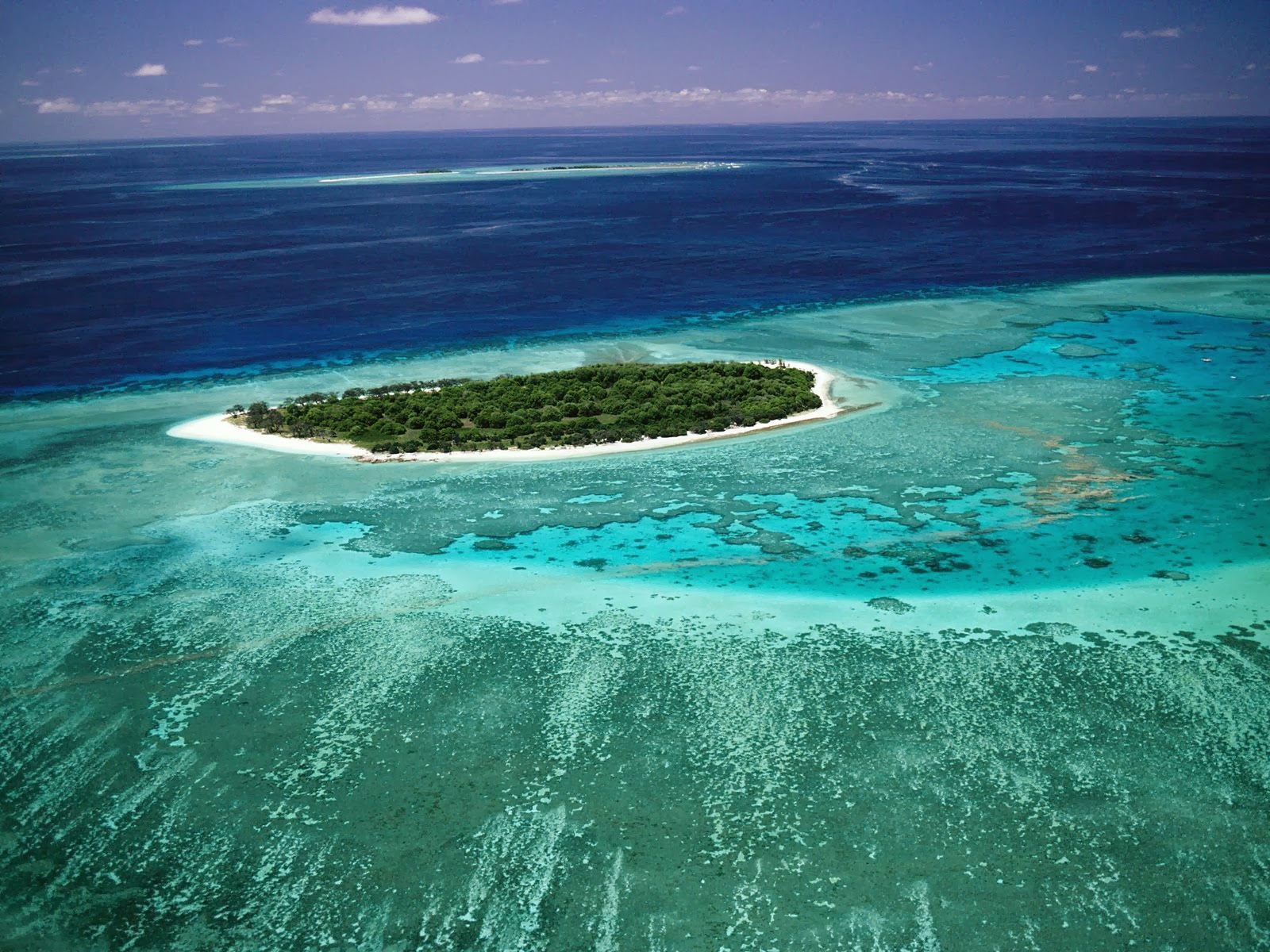
Visit the most beautiful place of the world to plan an exciting tour. One can visit this place to make an exciting tour. There are some more exciting place that provide you a cheap prices tour that you can visit by planning a tour of Shimla from Rajkot by flight option. This option provide you a affordable tour in your convenient price.